Matador Network's Blog, page 446
July 18, 2022
The House From ‘The Godfather’ Is Available To Book on Airbnb This August

Airbnb is making an offer you can’t refuse. Just in time for the 50th anniversary of The Godfather , the Staten Island home featured in the movie is now available for an extended 30-day stay during the entire month of August. And while the house has had an upscale renovation, it still carries that Godfather charm.
Built in 1930, this 6,248-square-foot home can host five people with five bedrooms and seven bathrooms. The host describes it as the perfect home for two adults and three children. The exterior of the house is still completely recognizable from the iconic movie.

Photo: Marc McAndrews
Beat the heat and hang out in the backyard, where there’s a massive saltwater pool. There’s plenty of comfortable seating and tables and chairs to eat whatever’s cooking on the huge grilling station. Speaking of cooking, the kitchen has glorious amounts of natural lighting and plenty of crisp white finishes, stainless steel appliances, a ginormous fridge, and a TV.
There’s ample space in the living room and dining room for guests to gather. Head to the basement, and you’ll find a game room with a flat-screen TV, a foosball table, an arcade game, and a pool table. There’s even a pub with barstools and plenty of room for booze in the liquor cabinets. In the basement, there’s also a gym with a Peloton Bike, weight bench, treadmill, flat screen, and more.

Photo: Marc McAndrews
One lucky person will get to book a 30-night stay from August 1 through 31 will open on July 27 for only $50 per night in honor of the 50th anniversary. If you aren’t lucky enough to book the stay, you can still celebrate the iconic film by catching The Godfather in 4k on Paramout. 
This New Rollercoaster Has the Steepest Freefall Drop in the Western US

The right rollercoaster is pure adrenaline, and it seems that rollercoasters are getting bigger, faster, and higher all the time. If you’re chasing the next big thing, it might be time for a road trip to Colorado for make a stop in Glenwood Springs and a chance to take ride on the steepest freefall drop in the western United States — and the highest looping roller coaster in the entire United States.

Photo: Glenwood Caverns Amusement Park
On July 9, Glenwood Caverns Amusement Park debuted Defiance, a coaster that reaches up to 56 mph at 7,132 feet above sea level. On the drop, riders freefall from 110 feet at 102.3 degrees. If riders can gather their wits on the 56-second ride, they can take in the gorgeous views of Roaring Fork Rivers, Mount Sopris, South Canyon, Glenwood Canyon, and the city of Glenwood Springs. Other thrilling highlights are the 98-foot twisted top hat and switch, the 111-foot high-speed bank banana roll, and the 41-foot zero-g heartline roll. The rollercoaster can take 24 people at a time with three cars that each seat eight.
“With record-breaking elements, Defiance is sure to become instantly recognizable around the world,” said General Manager Nancy Heard in a press release. “Perched atop America’s only mountain-top theme park, riders will experience a thrill and view unlike any other and we are looking forward to giving our guests this unique experience.”

Photo: Glenwood Caverns Amusement Park
Defiance is now available to ride Monday through Thursday from 9 AM to 7 PM and Friday through Sunday from 9 AM to 9 PM. To ride Defiance, amusement park goers will need to purchase the Funday ticket package for $67, which includes all the park has to offer, including the mountain-top gondolas, several different tours and coasters, laser tag and more. The park also sells annual passes starting at $195. 
Experience the Best of Coastal Life at These Top-Rated Virginia Beach Airbnbs

With its atmospheric promenade, buzzing ViBe Creative District, and ocean-fresh shellfish, Virginia Beach is the place to go this summer. Rather than spend all your time surfing the web when you could be chasing your next wave, peruse our selection of the coolest Virginia Beach Airbnb rentals.
Oceanfront Virginia Beach AirbnbsVirginia Beach house rentals with private poolsSanbridge beach rentalsUnique Airbnb Virginia Beach vacation rentalsPet-friendly Virginia Beach AirbnbsWe hope you love the Virginia Beach Airbnb rentals we recommend! Just so you know, Matador may collect a small commission from the links on this page if you decide to book a stay. Listed prices are accurate as of the time of publication.
Oceanfront Virginia Beach AirbnbsOceanfront Airbnbs in Virginia Beach should offer two things: a quick walk to the shore and easy access to the town center. These vacation rentals offer both, with the bonus of being quite comfortable on the inside. You’ll find them both convenient and relaxing for your VB trip.
Seaside Sanctuary Oceanfront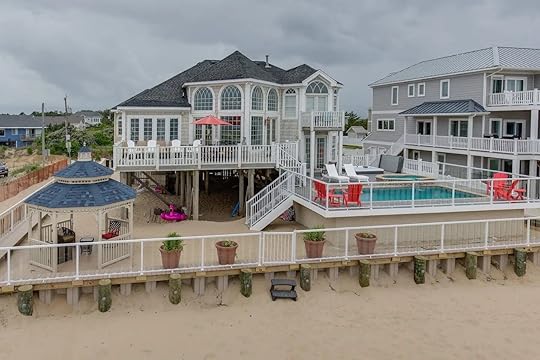
Photo: Airbnb

Photo: Airbnb

Photo: Airbnb
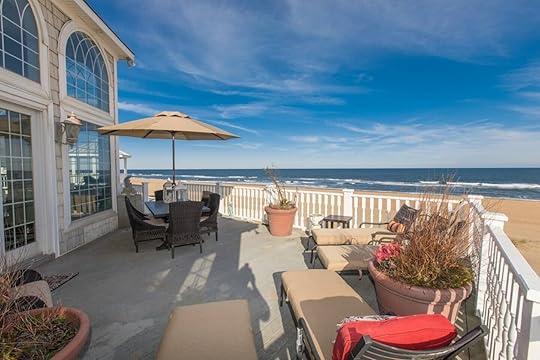
Photo: Airbnb
This opulent vacation home in Sandbridge, South Virginia Beach, sets out to impress with its monumental windows, chandeliers, fireplaces, and period furniture. A verandah overlooks the beach and provides ample space for dining and sunbathing. The lower level of the patio has two swimming pools connected with a waterfall feature as well as a hot tub. You’d struggle to find pet friendly vacation rentals in Virginia Beach as lavish as this one!
Twelve guests, five bedrooms
Price: $1,250 per night
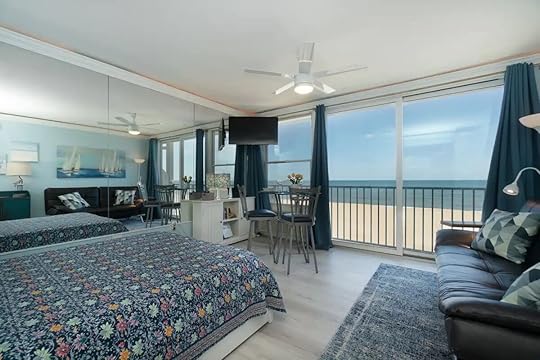
Photo: Airbnb

Photo: Airbnb

Photo: Airbnb
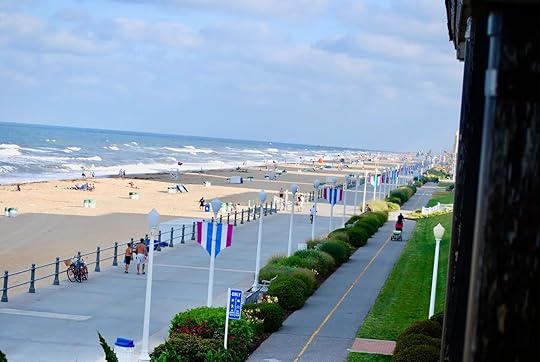
Photo: Airbnb
Ogle the Atlantic Ocean from bed at this beachfront Airbnb in Virginia Beach. Floor-to-ceiling windows and a Juliette-style balcony capitalize on the views. Awesome for a couple, the studio is equipped with a kitchenette and dining table overlooking the water. You’ll have access to a shared pool and the private lawn leisure area during your stay at this centrally-located condo.
Two guests, one bedroom (studio)
Price: $210 per night

Photo: Airbnb
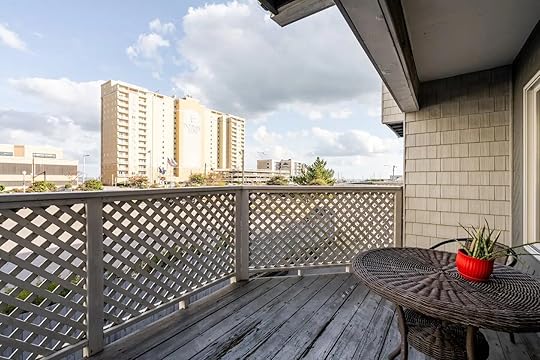
Photo: Airbnb

Photo: Airbnb
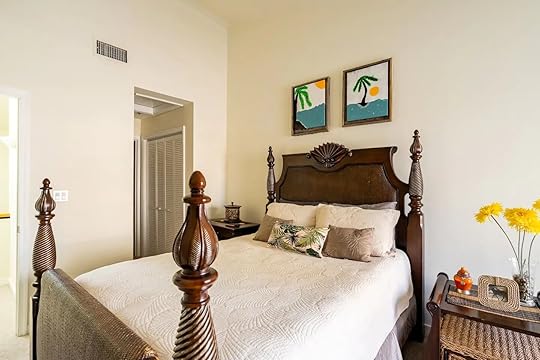
Photo: Airbnb
This sophisticated condo is ideal for those seeking Virginia Beach oceanfront vacation rentals that merge the convenience of downtown with a quiet setting. Located steps away from the sand near the Rudee Inlet, this homely residence comprises two double rooms and two bathrooms. The balcony is perfect for a sundowner.
Five guests, two bedrooms
Price: $230 per night
You and your crew want an Airbnb in Virginia Beach with a pool. These vacation rentals satisfy that desire, with plenty of space to lounge around said pool and an easy walk or bike ride to other attractions. Particularly if you’re visiting with a group, these are the best options in VB.
The Sandbridge Jewel
Photo: Airbnb

Photo: Airbnb

Photo: Airbnb
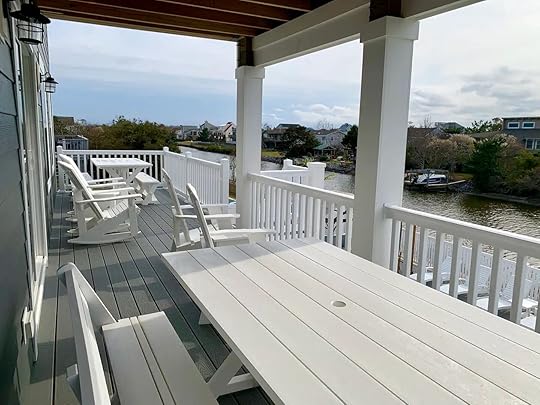
Photo: Airbnb
Located in tranquil Sandbridge, this supersized vacation rental has bags of space to congregate with your loved ones or snatch an afternoon of solitude. Spanning three levels, this family-friendly Airbnb at Virginia Beach has the added perk of a gym and kids’ playground. A private backyard overlooks the canal and contains a sundeck and private pool.
Sixteen guests, eight bedrooms
Price: $1,200 per night
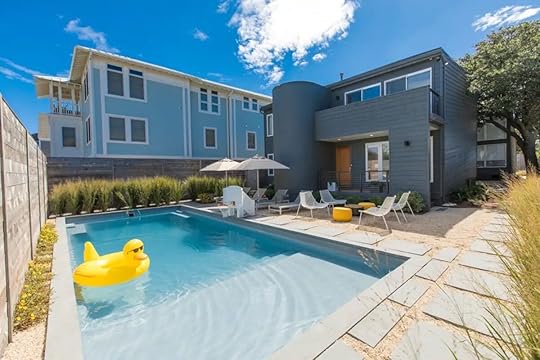
Photo: Airbnb

Photo: Airbnb
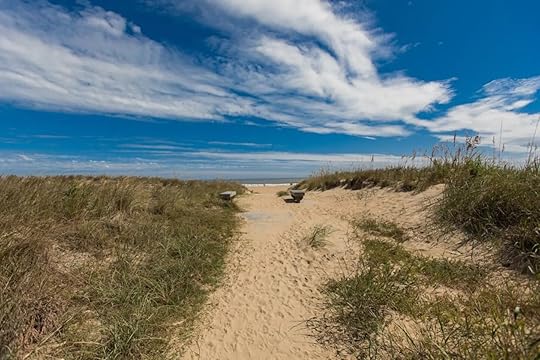
Photo: Airbnb

Photo: Airbnb
Situated in the North End, this Airbnb Virginia Beach with a pool consists of two properties that share a backyard. There are four bedrooms in the main house with an additional two beds, two bathrooms, a kitchen, and a lounge in the adjacent guest house. There is tons of light thanks to the plentiful windows and glass porch and a large fireplace for cozy nights in.
Twelve guests, six bedrooms
Price: $750 per night

Photo: Airbnb

Photo: Airbnb

Photo: Airbnb

Photo: Airbnb
In terms of where to stay near Virginia Beach Boardwalk in the heart of the action, you can’t beat ViBE. This modern home is mere blocks from the beach and cultural attractions this neighborhood is famed for. But, with a private pool, large backyard, and gorgeous interiors, you might be tempted to spend the whole trip making the most of this cracker of an Airbnb.
Ten guests, three bedrooms
Price: $470 per night
South of Virginia Beach proper, Sandbridge Beach provides an extra dose of peace and quiet. It’s located just off False Cape State Park and gives you ample opportunity for outdoor adventure. These Sandbridge, Virginia, Airbnbs put your right near all everything there is to do.
The perfect 7-bedroom Sandbridge Beach vacation rental
Photo: Airbnb

Photo: Airbnb

Photo: Airbnb

Photo: Airbnb
There’s something about falling asleep to the sound of crashing waves, and then waking up to a dip in the pool, that instantly relives the mind of big-city worries. This Sandbridge Beach mansion can accommodate your entire crew and is just a stone’s throw from the sand. You’ll have a private pool, two wraparound decks, and a hot tub. You’ll also be within walking distance to everything, should you decide to venture away from this beautiful home.
Sixteen guests, seven bedrooms
Price: $820 per night

Photo: Airbnb

Photo: Airbnb

Photo: Airbnb

Photo: Airbnb
If you want to have your toes in the sand within five minutes of waking up in the morning, this is your spot. This Sandbridge beach house rental has. a deck overlooking the water, pool and foosball tables in the living room, and an outdoor BBQ station. Stock your own private beach bar and have a party on the sand with your crew. Bedrooms are well-trimmed and spacious, and to top off its chill vibes, this property also has plenty of space for personal relaxation time.
Eight guests, three bedrooms
Price: $800 per night

Photo: Airbnb

Photo: Airbnb

Photo: Airbnb

Photo: Airbnb
This ground-floor unit is adjacent to the beach and includes beach gear for your days on the sand. The owner suggests that dolphins are often visible from the beach here. At the unit, enjoy a comfortable, nautical-themed layout that sets the mood for your beach getaway. There’s a kitchenette, though you’ll also be near the main strip of Sandbridge which is home to many of the VB area’s best restaurants.
Two guests, one bedroom
Price: $234 per night
WHy stay in the same old, same old? These Virginia Beach Airbnbs add a bit spice to your time away.
The Old Salt
Photo: Airbnb

Photo: Airbnb

Photo: Airbnb
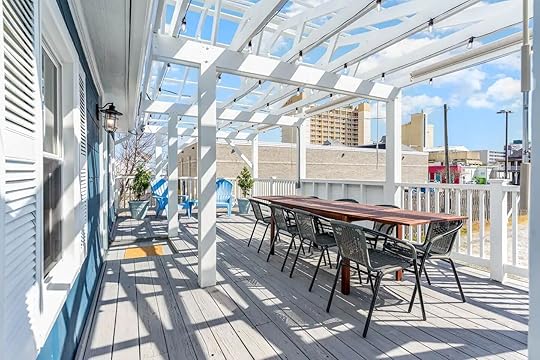
Photo: Airbnb
Renovated in 2021, this cute vacation rental was built in 1910. Contemporary interiors are minimalistic but nod at a shoreside theme with maritime relics and artworks. A partially covered terrace awaits you on the second floor where you can sip your morning brew (or linger over a homemade mojito in the evening). Best of all, this Virginia Beach Airbnb is fitted with a generous stash of bodyboards for guests to grab and go.
Six guests, three bedrooms
Price: $300 per night

Photo: Airbnb

Photo: Airbnb

Photo: Airbnb
This desirable North End Virginia Beach Airbnb with a hot tub is impeccably presented with an open-plan kitchen and lounge and four spacious bedrooms. Your private terrace is fitted with a beautiful seating area and a bubbling spa bath. Although you might not see the ocean from the property, rest assured that you’ll hear it. The beach is a five-minute walk away.
Nine guests, four bedrooms
Price: $725 per night

Photo: Airbnb

Photo: Airbnb

Photo: Airbnb

Photo: Airbnb
This kooky rental in the ViBe neighborhood strikes a balance between home comforts (think fireplaces and Chesterfields) with seaside embellishments. Bicycles and surfboards are available for guest use and there is a billiards table for fun nights in. One of the homeliest luxury vacation rentals in Virginia Beach has to offer families and groups of friends.
Eight guests, three bedrooms
Price: $390 per night
Dogs love running on the beach just as much as people love walking on the beach. It’s good for them, and good for you. These Virginia Beach vacation rentals are pet-friendly so the entire family can come along.
The Original Beach Cottage
Photo: Airbnb

Photo: Airbnb
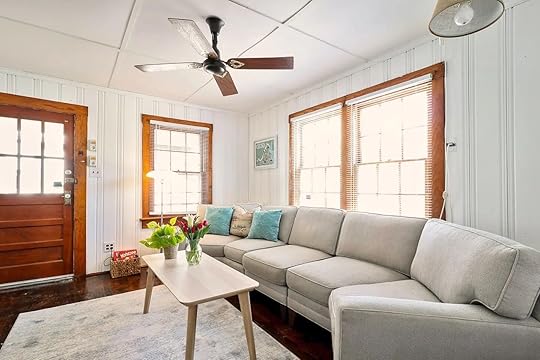
Photo: Airbnb
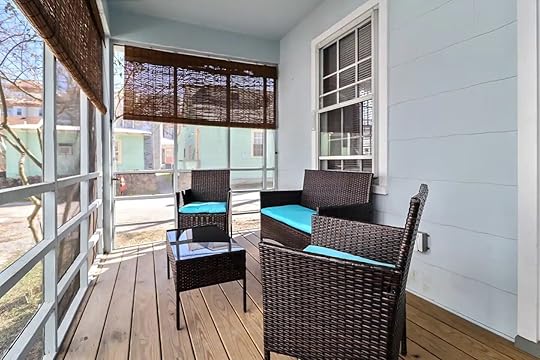
Photo: Airbnb
This chic beach house is one of the best pet-friendly vacation rentals in Virginia Beach. Perfect for families, the property features a master bedroom plus a room fitted with a double and a bunk bed – perfect for that slumber party vibe. The interiors have ample space for spreading out while the backyard comes with a barbecue for casual family dinners. It’s super central; you can walk to the boardwalk and ViBe without breaking a sweat.
Six guests, two bedrooms
Price: $290 per night

Photo: Airbnb

Photo: Airbnb

Photo: Airbnb

Photo: Airbnb
Our final pick of luxury vacation rentals in Virginia Beach ticks all the boxes. The vast beach house is the vacation home of the host and it chimes with homely touches, particularly in the children’s bedroom. There is a pool, a roof deck with a barbecue, and access to a private beach. Subject to a surcharge, dogs are welcome at this lovely family home near the Rudee Inlet. 
Fifteen guests, four bedrooms
Price: $525 per night
You Can Drive in a Real-Life Mario Kart Race on a Swiss Mountain

As I sat helmet-clad and poised to race down a mountain track, I realized all the Nintendo 64 training from my formative childhood years was finally about to pay off. My hours spent trying to press the “A”button exactly when the race started and trying to use my single-mushroom power-up for a boost near the end of Rainbow Road were about to come in handy – in Switzerland, of all places.

Photo: Lauren Breedlove
The backdrop for this Mario Kart in real life was Grindelwald First, Switzerland’s peak in the Jungfrau Region dubbed the ‘Top of Adventure.’ Travelers and hikers come to stroll on the mountain past stunning peaks, valleys, and wildflowers (and Swiss cows, of course).
As a child of the ’80s, the thought of riding an off-road version of my beloved Big Wheels had me in a seriously amped-up mode. Add in the Swiss scenery and, well, I was about to burst with excitement.

Photo: Lauren Breedlove
Steering down the almost-two-mile track on a glorified tricycle doesn’t require banana peels or tortoise shells, but it does call for some savvy maneuvering, as I found when I plowed through a giant load of cow poop at top speed. That didn’t stop me, though: my inner Mario was having way too much fun.
Fortunately, driving your own Mario Kart in real life – called mountain karting – is easier to experience than you’d think, whether you’re a Yoshi, a Mario, or even a Donkey Kong at heart.
What is Mountain Carting?
Photo: Lauren Breedlove
The cart idea was born out of the Swiss passion for sledding, believe it or not. With a hybrid go-kart/sled design, this set of wheels brings a bit of the joy of downhill sledding to summer with a race down Grindelwald’s resident mountain, 7,112 feet above sea level. The alpine scenery is breathtaking as you move along the path between the Schreckfield and Bort cable car stations. This real-life Mario Kart is an alternative way to travel down the mountain as opposed to taking the cable car, which offers far fewer opportunities to yell “Let’s-a-go!” or “Mamma Mia!” at high speeds.
The rugged wheels can tackle pavement, grass, and gravel, which is good because the 1.8-mile track is a smorgasbord of that exact terrain. However, the hand brakes are easy to use and the vehicle’s low center of gravity feels solid and manageable on twists and turns.

Photo: Lauren Breedlove
The track is wide enough to pass slow carters (or avoid cow poop), and the winding switchbacks, cliffs, and 90-degree turns add a bit of spice to the ride. The seat is comfortable enough, and with no pedals, you just prop your feet up and let gravity and momentum do their thing, controlling your pace with the brakes. It’s a choose-your-own-adventure in a Swiss paradise.
Though it’s not actually meant to be Mario Kart in real life, and there are no winners, power-ups, giant lava balls, or green pipes you’ll need to fly through, it’s certainly reminiscent of the game. And in some ways, it’s better than the game – you can grab fondue at the bottom past the finish line as you watch the next round of carts come down.
Where is this real-life Mario Kart?
Photo: Lauren Breedlove
Grindelwald is in the Jungfrau Region of Switzerland, roughly a three-hour train ride from the Zurich airport. Once in town, head to the Grindelwald First cable car station and purchase a ticket for your transport up (32 Swiss Francs). The ride itself is enjoyable, with approximately 25 minutes to drool over the mind-blowing scenery.
The mountain cart starting point is Shreckfield, the second gondola stop out of the three total stations. If you’d like to do some of the activities at the First summit or visit the restaurant, go to the top and work your way down to carting when you’re ready to leave.
Carting logistics
Photo: Lauren Breedlove
Mountain carting is open from mid-May to mid-October and is weather dependent. Wait times to get your hands on a cart vary, but an up-to-date sign keeps you in the loop. It costs 21 Swiss Francs to do it, not including the gondola ride up to the top. When you get in line, you’ll fill out a standard waiver before showing your ticket, which can be purchased online beforehand. Then, you’ll grab an appropriately sized helmet and cart and hear a quick introduction to the cart before rolling onto the track. Wearing a backpack is fine as long as your hands are free.
If you want to try more than just the carts, you may want to purchase the Adventure Package instead, which offers discounts based on how many activities you plan to try.
Other things to do
Photo: Lauren Breedlove
As the ‘Top ofAdventure’ name suggests, Grindelwald First is a base for adventuring – and adventure there is. Aside from living out your dream of playing Mario Kart in real life, you can embark on a variety of hikes, test your fear of heights on the First Cliffwalk, or dine at the mountain restaurant before taking the First Flyer down to the Schreckfield station, where mountain carting and the First Glider await.
Once you cross the finish line at the Bort cable car station with your mountain cart, you can trade it in for a Trottibike – another hybrid mash-up of a scooter and a bike. You can ride that through bucolic alpine meadows filled with cute little cheese houses on the way down to the village of Grindelwald. If you opt not to do the Trottbikes, you can take the gondola back down to the starting point, instead.

Photo: Lauren Breedlove
Where to stay in Grindelwald
Photo: Lauren Breedlove
The charming mountain village of Grindelwald is the perfect base for adventuring around the area. If waking up to gorgeous views is your thing, Bergwelt Grindelwald ticks that box and more, with an on-site restaurant, bar, and spa. You can also walk from the hotel to the Grindelwald First cable car station in just five minutes.
For a more budget-friendly offering, check out the nearby Jungfrau Lodge, with basic but comfortable rooms and an included breakfast buffet just a 10-minute walk to town. 
6 Must-See Waterfalls Near Portland You Can Reach in Half an Hour

Portland is a captivating city, with all the scenes that make a place stand out as a must-see destination – unique art, sustainable and historic architecture, original food and restaurants, tasty craft beer, and quirk – lots of it.
So while it’s tempting to spend your entire PNW trip downtown, you’d be remiss if you didn’t make a quick trip to one of the nearby Portland waterfalls. One of the city’s best features is its proximity to some of the most stunning displays of natural beauty in America – like the Columbia River Gorge, which is home to the highest concentration of waterfalls in the country. But there are great falls just across the border in Washington, too.
You could easily spend a week exploring what’s known as the “Waterfall Corridor,” but if you’re limited on time and can only see the top-shelf collection, here are the best waterfalls near Portland to visit within about 30 minutes of downtown (pending traffic, of course).
Latourell Falls
Latourell Falls
Latourell Falls is within Guy W. Talbot State Park, off Exit 28 on the Columbia River Gorge Highway. It’s an easy one-mile round trip walk to the Lower Falls and historic 1914 Latourell Creek Bridge at the base of the falls. From there, you can look up at the dramatic 224-foot, single-plunge waterfall that drops straight down from a massive basalt rock blanketed by thick yellow lichen.
If you’re game, you can take a moderate two-mile roundtrip hike to Upper Latourell Falls. And if you have time beyond that, add in a visit to Shepperd’s Dell Falls. It’s about a mile down the road and has just a short stroll to reach the viewpoint. It’s a two-tiered waterfall that tumbles a combined 92 feet over steep cliffs into Young’s Creek on its way to the Columbia River.
Multnomah Falls
Photo: f11photo/Shutterstock
The most famous waterfall near Portland is Multnomah Falls on the Historic Columbia River Gorge Highway. It’s the tall, iconic waterfall behind the Creek Bridge; you’ve probably seen it on a screensaver or default desktop background.
With a drop of 620 feet, it’s Oregon’s tallest waterfall and is visited by more than two million people yearly. It’s become so popular that timed use permits are required between late May and early September. Fortunately, the entry fee is only $2 per adult for a one-hour time slot, and you can buy the permits on Recreation.gov, usually for the same day, or one day in advance at the longest.
From the viewpoint, travelers intent on seeing the best Portland waterfalls on foot can take the Wahkeena Falls Loop trail. It’s a moderately challenging, five-mile loop past six waterfalls, including Fairy Falls – a particularly enchanting 20-foot waterfall fanning out over several rocky clusters. Fairy Falls is worth a visit even if you skip the others entirely.
Bridal Veil Falls
Photo: Gary Gilardi/Shutterstock
This two-tiered stunner is 120 feet tall and just a 15-minute walk from the Bridal Veil Falls parking lot, offering remarkable views of the Columbia River along the way. Though not the most original name, considering there are also waterfalls in Alaska, California, Colorado, New York, South Dakota, and Utah with the same moniker, it’s nonetheless spectacular and deserving of its local celebrity status among Portland waterfalls.
You’ll hear it before you reach the viewpoint, from where you’ll have views of a roaring double fall pouring over moss and ferns. Indeed, it does look like a bride’s wedding veil. For a thoughtful touch for friends back home, buy some postcards at the gift shop and mail them from the impossibly quaint Bridal Veil post office down the street from the parking lot.
Woodburn Falls
Photo: marcsanchez/Shutterstock
If you’d prefer to avoid dealing with reservations and crowds around the Columbia River Gorge area, head instead just across the Washington State border to Lacamas Regional Park, less than half an hour northeast of Portland. The park’s multiple falls aren’t as large as those farther east, but they’re beautiful, easy to access, and some of the best waterfalls near Portland to see while trail running or mountain biking (both of which are allowed in the park).
If you take the park’s Woodburn Falls and Round Lake via Lake to Lake Trail, you’ll pass two waterfalls over the course of about three miles: Woodburn Falls and Pothole Falls. The latter is a popular place to cool off mid-hike if you visit in the peak of summer. The trail can sometimes get muddy and slippery, so wear shoes with good grip and use your hands and feet if you decide to scramble up any rockfalls or steeper traverses.
Dry Creek Falls
Photo: Sveta Imnadze/Shutterstock
Surrounded by an arena of moss-covered basalt rock colonnades, Dry Creek Falls descends 74 feet into a rocky apron of boulders. Accessed via the Bridge of the Gods Trailhead or the Pacific Crest Trail Cascade Locks Trailhead, it takes most people about two hours to hike the easy 4.4-mile, out-and-back trail (which also offers a chance to hike along the world-famous Pacific Crest Trail).
This area was heavily damaged by the Eagle Creek Fire in 2017 and was finally reopened in July 2020, so you’ll notice blackened tree trunks and other devastation from the burn. There’s also an old water diversion structure from the 1930s at the base, which used to provide water for the nearby town of Cascade Locks.
Oneonta Falls
Photo: Ryan Kelehar/Shutterstock
There are three waterfalls in the Oneonta circuit: Upper, Middle, and Lower Oneonta Falls. There are a few choose-your-own-adventure options to see all three of the Oneonta Falls and trail offshoots to connect the loop to Triple Falls and Horsetail Falls. Triple Falls is one of the most photogenic waterfalls near Portland thanks to its three distinct channels, or fingers, which drop more than 60 feet down sheer walls into Oneonta Creek.
Many visitors tackle the steep ascent to Triple Falls early in the hike before descending to the Horsetail Falls junction to see Middle and Lower Oneonta Falls in a lush gorge near the mouth of Oneonta Creek. From there, hikers can either return to the Oneonta Trailhead or continue on the path behind Ponytail Falls, an 88-foot-tall fall flowing from a rocky outcrop.
The trail ends at Horsetail Falls and has unobstructed views of the 176-foot-tall falls flowing into an emerald plunge pool. The trails are moderately challenging and can get slippery, so shoes with good traction are key. Note that parts of Oneonta Gorge are still closed from a devastating 2017 fire, but you can use this site to check the status of everything in the area.
Waterfall Shuttles & E-Bike Tours
Photo: Bob Pool/Shutterstock
If you don’t have a car or don’t want to drive to see the best Portland waterfalls, book a spot on the hop-on, hop-off Sasquatch Shuttle for $15 or Waterfall Trolley for $21; the latter includes a reservation for Multnomah Falls.
Another great way to see these falls is to book an e-bike tour to five, seven, or nine waterfalls, depending on which tour you choose and how long you want to spend on a bike.
Where to Stay
Photo: Hotels Zags
Hotel Zags is a newly redesigned, chicly decorated hotel in downtown Portland. In addition to modern rooms, it has unique amenities like a game room and a gear shed with GoPro cameras, backpacks, bikes, and skateboards available for guest use.
For something closer to the falls but still within a quick drive of the city, consider one of the basic and reliable hotels in Troutland, considered an east suburb of Portland. The Best Western Plus Cascade Inn & Suites, Holiday Inn Express Portland East, and Hampton Inn Portland East are all easy places to spend the night if you’re keen on spending your budget on exploring Portland’s food and drink scene instead. 
7 French Beaches Where the Locals Vacation

When it comes to where French people vacation, why would they feel the need to go anywhere else when there are more than 2,600 beautiful beaches and over 3,400 miles of coastlines just a car ride or train trip away? While the summer exodus of French people from cities to seaside towns means that Paris is empty for all the foreign tourists to enjoy in peace, visitors would be remiss not to leave the Louvre behind to test out the water and enjoy some sun tanning sessions on the most popular French beaches.
As well as being some of the most beloved destinations in France, the following French beaches have all been awarded the Pavillion Bleu (Bleu Flag) certification, guaranteeing a high level of cleanliness, accessibility, safety, and environmental protection. That does not mean, however, that these French beaches are tranquil — most are very busy in July and August. For a more peaceful beach session, visit in June and September.
The best French beaches in NormandyPlage de Fécamp, Seine-Maritime[image error]Photo: Henryk Sadura/Shutterstock
The appeal of Fécamp Beach is the view of the dramatic white-chalk cliffs that you have from your towel. While not as iconic as the vista you’d get from Etretat Beach featuring the famous arch, Fécamp Beach was, unlike Etretat, awarded the Pavillon Bleu certification this year, making it a better place to enjoy the English Channel. And Etretat is only 25 minutes away by car, so you can easily go to see the famous arch when motivation strikes. Cape Fagnet, in the town of Fécamp, is one of the best viewpoints in the area to see the majestic cliff coast, so stop by after your day at the beach to see the area’s natural beauty from up high.
Note that Fécamp Beach is a pebble beach, so set your towel not too far from the water’s edge so your feet won’t suffer.
Plage de Colleville-Montgomery, Calvados[image error]Photo: Mairie de Colleville-Montgomery /Facebook
Deauville and Trouville-sur-Mer are the Normandy beaches favored by chic Parisians on weekend getaways, but who wants ritz and glamor when they can have World War II history instead?
Colleville Beach is so peaceful and scenic that you’d never know it was one of the sites of the Normandy landings on June 6, 1944. Colleville Beach is located about 10 minutes by car from Sword Beach; about 20 minutes from Juno Beach and the Juno Beach Center; and less than one hour from Omaha Beach, the Overlord Museum, and the Normandy American Cemetery. While in the small town of Colleville-Montgomery, visit the Hillman Fortress, a complex of German bunkers built in 1942. If you want to visit the sites of the Normandy landings more extensively, check out Matador Network’s guide for a D-Day tour of the region.
Colleville Beach is 2,000 feet long, covered in fine sand, and flanked with a natural dune carpeted in vegetation. The beach has lifeguards throughout the summer months from 11:30 AM to 8:30 PM and is suitable for those who wish to sunbathe, swim, or indulge in some water sports. The lifeguard post also has all the equipment necessary for people with disabilities to be able to access the beach and swim. The beach has been awarded the Pavillon Bleu certification for 21 years in a row.
The best French beaches on the Atlantic coastLa Grande Plage de Carnac, Morbihan
Photo: fabien babonneau/Shutterstock
La Grande Plage de Carnac (Carnac’s Large Beach) is right in the heart of the town and is therefore the most easily accessible of the five beaches to be found in the area. With its 1.2 miles of fine sand and its clear waters, it’s a great place for everyone to swim safely. The beach has lifeguards throughout the summer and is accessible for those with reduced mobility.
Once you’ve spent the day at the beach, wander the lovely streets of Carnac and pop into the independent shops for trendy clothing, books, or souvenirs. The Diana Hotel that faces the beach is a great place for a gourmet ice cream or a refreshing cocktail. If you prefer to take a walk, follow the promenade along the coast and admire the beautiful historical properties that face the ocean.
Just make sure you don’t spend all your time at the beach. Carnac is most famous for being home to the largest gathering of enigmatic sanding stones dating back 7,000 years. The impressive megalithic alignments are a sight to see so grab a map at the tourist office and walk the trails around the 3,000 stones.
La Baie de La Baule, Loire Atlantique[image error]Photo: Altitude Drone/Shutterstock
One of the longest beaches in Europe, the La Baule Bay is more than 5.5-mile long and encompasses three towns: Pornichet, La Baule, and Le Pouliguen. Many of the beaches along the bay have been awarded the Pavillion Bleu certification, but some are more attractive than others. For example, Benoît Beach, in front of La Baule’s famous luxury hotel L’Hermitage, has very fine white sand and shallow waters, especially at low tide, making it a safe place for families.
The area is great for shopping and trying out local treats. The Avenue de Gaulle, the coolest and fanciest street in La Baule, has a huge variety of clothing shops at a different price points, ice cream parlors (the homemade strawberry ice cream from La Fraiseraie is a must-try), and waffle and candy vendors (paying a regular visit to Manuel is a local tradition.)
La Baule Bay is extremely popular with tourists in the summer, but come the end of August and the start of September, the beaches are nearly empty and you can enjoy miles of sand with very few people around.
Plage des Deux Jumeaux, Hendaye, Pyrénées Atlantiques
Photo: Hans Geel/Shutterstock
The Deux Jumeaux Beach is a very scenic spot to swim, sunbathe, and learn how to surf. The beach has lifeguards throughout the summer so those who want to test out the warm waters (the temperature can reach 73 degrees) can do so safely. While the section of the beach nearest the cliffs was dedicated to those who enjoy the seaside in the nude, unfortunately the practice was banned in 2021. That said, note that anyone can go topless on most French beaches.
For great views of this beautiful stretch of the Atlantique coast, hike the path that links the town of Saint-Jean-de-Luz to Hendaye. It’s a moderate three-hour walk, and you’ll sure have deserved a swim and a rest in the sun on the Deux Jumeaux beach afterwards.
Located at the border between France and Spain, you can easily pop down from Hendaye to San Sebastian for the day and try out Basque country’s famous food and a glass of Kalimotxo, a Basque specialty that consists of mixing wine and Coca-Cola.
The best French beaches on the Mediterranean coastThe beaches and coves of Cassis, Bouche-du-Rhône
Photo: Daniel Pahmeier/Shutterstock
The French Mediterranean coast is packed with great beaches, including the ones on the famous French riviera in Nice, Cannes, and Saint-Tropez. But for one area that defines the beauty of the French Mediterranean coastline, it’d be the beaches and coves in and around Cassis. Two beaches in the small and pretty town of Cassis have received the Pavillon Bleu certification: Bestouan Beach and Grande Mer Beach and both are extremely scenic, although super busy in the summer. If you are able-bodied and have a car to move around, check out the coves of Cassis (known as “calanques” in this part of the world), namely Port-Pin and En-Vau. They are very popular during the summer months, but the water is so clear and the surrounding cliffs so exceptionally beautiful that it’s worth fighting for a spot on the sand. Bring your snorkel gear to the coves and look for the small marine creatures that inhabit this beautiful spot.
Plage Terre Sacrée, Ajaccio, Corsica
Photo: Sasha64f/Shutterstock
Mainland French vacationers love to fly or sail to Corsica in the summer, and for good reasons. The weather is seemingly always sunny and hot, the water is warm, and no matter where you go on the island, the scenery is stunning.
Two sandy beaches in the capital city of the region of Corsica, Ajaccio, have been awarded the Pavillon Bleu certification: Trottel Beach and Terre Sacrée Beach. Trottel Beach is right in town, while Terre Sacrée Beach is a beautiful 15-minute drive to the west, but both are accessible for those with mobility issues.
A memorial on Terre Sacrée Beach, pays tribute to the French and allied soldiers who were hurt or died during World War I. It is one of six such memorial markers in the world, five of which are in France and one in the United States. Make sure to take the time to stop by.
For those who like to work hard to earn their relaxing time at the beach, the Chemin des Crêtes (the Ridge Path), a 6.2-mile hiking path with views of the city and coastline, is accessible to all who can handle a few steep inclines and some patches of rough terrain. It starts in town and ends at Terre Sacrée Beach. 
A Michigan Travel Guide for the Digital Nomad

With an abundance of both urban action and pristine wilderness, Michigan is an ideal place for adventurous digital nomads. There’s so much to see and explore — from endless coastlines to massive sand dunes to dense forests — that going remote in the Great Lakes State truly puts the good life at your doorstep. All you need to do is add wifi.
And that’s where Michigan’s vibrant cities come in — many of them located right on the water — ready to meet all your on-the-clock needs. If you’re looking for that sweet spot, sandwiched between the best of both worlds, give these Michigan destinations a look.
Grand Rapids | Lake Michigan
Photo: Pure Michigan
The river-rich Grand Rapids is Michigan’s second-largest city, known for kayaking, mountain biking, hiking, and a long list of top-tier breweries to pair with all that outdoor action.
For workAs a city some 200,000 strong, Grand Rapids offers digital nomads an advantage when it comes to finding comfortable and stylish settings in which to carve through that inbox.
The collaborative co-working space The Factory sells single-day passes to varying levels of monthly memberships. Depending on your needs, you can hang out in the gathering area, kitchen, or conference room.With two locations in Grand Rapids, The Sparrows Coffee & Tea & Newsstand sells organic coffee and loose-leaf teas along with a myriad of magazines to flip through when it’s time to take a work break. Plus, it’s open until 7pm.Rowster Coffee has a spacious, industrial feel, making it easy to spend the day here. Sip on their nitro cold brew to really give your workday some momentum.If you want to post up somewhere that makes the transition from morning coffee to afternoon wine seamless, check out Squibb Coffee & Wine Bar.For playGive your eyes a break from the screen and get outdoors at Frederik Meijer Gardens & Sculpture Park, a sprawling botanical garden that doubles as an outdoor art gallery with over 200 towering sculptures. It’s open year-round, but a warm-season highlight is their summer concert series, with acts like Sheryl Crow and ZZ Top coming to call.
Just minutes from downtown, Blandford Nature Center is home to rehabilitated animals no longer able to survive in the wild. Spend an afternoon traversing their gentle loop trails (keeping an eye out for animal sightings!).
A 45-minute drive from Grand Rapids is Saugatuck Dunes State Park, where ancient coastal dunes rise up to 200 feet. Climb to the top of one for a rewarding trek, or stroll the 13 miles of trails and 2.5 miles of glittering Lake Michigan shoreline. Just 15 minutes south of the park you’ll find Oval Beach, a stunning beach on Lake Michigan with a picnic area.
Traverse City | Lake Michigan
Photo: Pure Michigan
Traverse City swells with Michiganders and Chicagoans heading “up north” for cooler temps and quintessential northern Michigan fun. But it’s so much more: The city is home to artists, chefs, winemakers, brewers, small-business owners, and outdoor enthusiasts all passionate about their little slice of heaven.
For workTraverse City offers several different co-working spaces with reservable seats, along with plenty of coffee shops featuring delectable menus and stunning views.
Commonplace calls itself “a community innovation hub,” where you can drop in for daily co-working or even rent a dedicated desk, cubicle, or office on a monthly basis.20Fathoms is a tech startup incubator that has a wide range of options to choose from, like reserving a dedicated desk or purchasing a five-day starter pack.Morsels sits just outside the high-traffic tourist areas of downtown TC, right on the water. This independent bakery and espresso bar serves Intelligentsia coffee and Kilogram tea and has gorgeous views of West Grand Traverse Bay.Brew does a small menu of hot breakfast items, pastries, salads, and sandwiches, as well as coffee, espresso, and teas — and beer, wine, and cocktails perfect for quittin’ time.For playYou’re only ever steps away from stunning scenery in the Cherry Capital of the World. Rent a bike and hop on the TART Trails network to explore the city and surrounding countryside, or grab a kayak and get out on the water during your lunch break.
When you’ve got a little more time to explore, make for one of the two peninsulas that jut out from the base of Traverse City: Leelanau and Old Mission, each of which are their own designated American Viticultural Areas. Together, they comprise the Traverse Wine Coast.
The Leelanau Peninsula is more than 10 times the size of Old Mission, so seeing it all can take some serious time. Stay the night at the Inn at Black Star Farms, situated on a sprawling winery estate in Suttons Bay. At the very tip of the peninsula, check out Leelanau State Park to walk the trails along Cathead Bay. When the sun sets, get ready for some seriously vibrant stargazing.
The Old Mission Peninsula may be smaller, but its scenery is nothing short of spectacular. At certain points, the peninsula becomes so narrow you can see the sparkling blue waters of both the east and west arms of Grand Traverse Bay flanking you — easily one of the most beautiful drives in America (with plenty of Michigan Wine Trail stops along the way).
Once you’ve finished exploring the wine coast, about 40 minutes west of Traverse City lies Sleeping Bear Dunes National Lakeshore, which has been called “The Most Beautiful Place in America.” It’s worth making a stop at all 12 scenic viewpoints along the 7.4-mile Pierce Stocking Scenic Drive, and if you need to stretch your legs and get some cardio in, try the 2.7-mile Pyramid Point loop trail. Hike alongside high bluffs, meadows, and maple-beech forests.
Houghton and Hancock | Lake Superior
Photo: Pure Michigan
The Keweenaw Peninsula is the Upper Peninsula’s upper peninsula. Your homebases here are the cities of Houghton and Hancock, essentially sister cities split by the Portage Canal. Houghton is a college town, while Hancock acts as a gateway to stunning scenery and adventure.
For workKeweenaw has all you need to knock out your workload, from spacious breweries to trendy co-working spaces (with free coffee!).
Get to work at the GrandBridge Business Centre in Houghton, which has open desks and private offices for affordable prices, as well as monthly memberships and conference room access.On the other side of the bridge, you’ll find all kinds of freelancers, remote workers, and startup teams at the stylish 101 Quincy in Hancock, where you can rent a workspace by the day, week, or month and get up to 24/7 access and free coffee.Houghton’s Camp Coffee makes a great latte, but come early — seating is limited in this cozy cafe.The massive Keweenaw Brewing Company in Houghton, on the other hand, has plenty of seating (grab a couch by the fireplace or sit on the deck outside), along with excellent beers and, of course, free wifi.For playSome of the most rugged, jaw-dropping beauty in Michigan can be found right here. Drive north to Copper Harbor and rent a mountain bike from Keweenaw Adventure Company. Those with experience can hit the challenging Copper Harbor Mountain Bike Trails, recognized by the International Mountain Bicycling Association as being among the top 20 trail systems in the world. The Keweenaw Adventure Company also offers sea-kayak rentals and guided tours.
Off in the distance sits Isle Royale National Park, the largest island in the largest freshwater lake in the world (Lake Superior really earns its name). Only two ports in Michigan run passenger ferry service to the least-visited national park in the Lower 48, and Copper Harbor is one of them. A three-hour ferry ride gets you to the island, where you can access 150 miles of shoreline, barrier islands, and fjord-like bays to explore by kayak.
If you’d rather skip all that pedaling and paddling in favor of keeping two feet on the ground, hiking in the Keweenaw proves to be some of the best in the Midwest. Staying in Copper Harbor, you’ve got Brockway Mountain and Bare Bluff in the Russell, to name just a couple options.
During winter, Houghton and Hancock put you less than an hour from one of the Midwest’s top downhill ski resorts, Mt. Bohemia. We’re talking all natural snow over 585 acres, plus more vertical and more expert terrain than anywhere else in the region. If your remote work schedule includes mandatory time off for powder days, this is the spot for you.
Bay City | Lake Huron
Photo: Craig Sterken/Shutterstock
Bay City is located at the base of Saginaw Bay on Lake Huron, bisected by the Saginaw River, and connected by four bridges. Parks, trails, and natural areas await the curious digital nomad once it’s time to shut that laptop.
For workBay City is rich with coffeeshop “offices” and co-working spaces to set up your own shop for the day.
At City Office, you have the run of five unique workstations, conference rooms, a game room, and a “dream kitchen.” Drop in for a day, purchase a punch pass, or opt for one of their monthly memberships that can include a dedicated desk with a locking filing cabinet and 24/7 access.CoWork by CMURC has multiple locations and options for open seating, dedicated desks, and private offices with monthly memberships and day, office, and meeting-room flex passes available.Populace Coffee serves excellent house-roasted coffees as well as teas and baked goods in a beautiful old building right downtown.Harless & Hugh Coffee specializes in hand-poured coffees and lattes made with house syrups, as well as beer, wine, and cocktails for those who work into happy hour.For playJust north of downtown, the 3rd Street Waterfall Park is tucked behind a parking lot along the Saginaw River and offers tranquil respite in the middle of the city. For a more extensive stretch of the legs during your workday, take a walk along the Riverwalk Railtrail, a paved path that travels through several greenspaces along the west bank of the river before jutting out as a boardwalk over the water itself.
Via the same Railtrail path, you can explore Middlegrounds Island — a long, skinny island in the Saginaw River. Start on the northern tip at Bigelow Park before traveling south to bike around the singletrack trail network known as Michigan Sugar Trails. Cyclists and walkers also enjoy the BayZil Rail Trail, a 7-mile paved rail trail that will eventually connect the Zilwaukee Pathway to the larger Great Lakes Bay Regional Trail.
For a longer day trip, head east to the Saginaw Bay of Lake Huron and check out Bay City State Park to explore iconic Michigan landscapes: a sandy beach, wetland woods, wet meadows, cattail marshlands, and oak savannah prairies. This park is also home to Tobico Marsh, one of the largest remaining freshwater coastal wetlands on the Great Lakes. Take it all in by walking the Tobico Marsh Trail, a gentle 3-mile loop.
No matter where you end up making your work-from-home base in Michigan, you’re just as close to unspoiled natural beauty as you are to a trendy coffeeshop with speedy wifi. If you’re lucky enough to have a flexible schedule and an itch for adventure, put Michigan on the itinerary and enjoy the best of both worlds. 
For the Other Side of California Wine Country, Turn To the State’s Brandy

Downtown Napa’s streets are filled with winery tasting rooms. Amid all the wine is a tasting room that opened during the pandemic with a different focus: the California Brandy House. Inside, live-edge Redwood tables, grapevine wallpaper, velvet booths, and a cross section of an old Redwood tree hanging from the wall make for an aesthetic setting to explore the other, stronger, side of California wine country.
California’s famous vineyards aren’t just for wine, after all. A handful of brands are showcasing how local grapes can make world-class brandy in addition to some of the best wine in the world. And at the California Brandy House, guests can go full circle and learn about how the state has a long history of brandy distilling.
California brandy makes sense from a big picture perspective. Great brandy takes great grapes, and few regions in the world can grow grapes like California. The very first California brandies were made by Catholic missionaries who started missions along the coast in the 1700s. In what is now San Diego, spirits were made from mission grapes that was largely used to fortify church wine.
Production in the San Joaquin Valley, just inland from San Francisco, started to rise exponentially decade over decade starting in 1865 in the wake of the gold rush. By 1890, a million gallons of brandy were reportedly made in California, according to a presentation by the late UC Davis brandy researcher James F. Guymon.
Even one of California’s most prestigious universities can trace its roots back to brandy: Leland Stanford had some 3,000 vineyard acres north of the Sacramento Valley in 1888, and in a few short years he was making 20 percent of all California brandy. Ownership passed to the university after his death, and wine and brandy continued to be made there until 1916.

Photo: Argonaut California Brandy
“We refer to brandy as the first and last frontier in spirits,” says Damon W. Boelte, owner of Brooklyn cocktail bar Grand Army and the experiential specialist at California Brandy House. At one point in America’s drinking history, brandy was the spirit of choice. Classic cocktails that are now often associated with whiskey were originally created with brandy in mind. The mint julep, for one, as well as the old fashioned (and if you’re in Wisconsin, you’re still likely to see brandy as the base spirit).
Yet while bourbon and rye whiskey have seen a resurgence with the growth of cocktail culture, brandy has yet to have its shining moment.
The center of California brandy in the state’s most famous wine region
Photo: California Brandy House
Nearly 4 million people traveled to Napa Valley before the pandemic, according to numbers from Napa’s tourism board. It’s slowly getting back to that level. And while they largely come for the wine, there are only so many wine tastings a person can do.
“This is where we offer something different in wine country,” says Reza Esmaili, senior brand ambassador at Gallo Brandies. “After you have seven amazing California cabs, the eighth doesn’t taste as good as the first or second.”

Photo: California Brandy House
E&J Gallo is to thank for bringing this particular something different. The expansive alcohol conglomerate is behind the most recent push to raise awareness for California brandy, but it’s not exactly new to the category: E&J Brandy started in 1975, and in short order became the go-to name in affordable brandy in the United States. The company ventured into craft brandy production when it purchased Germain-Robin in 2017 and launched Argonaut in the same year.
The two brands are at the forefront of the California grape brandy movement, along with smaller brands like Omage, Charbay, and distillers farther down the state in Paso Robles like Pendray’s.
Of these, Germain-Robin is perhaps the most cherished. The brand is named after its founder, Hubert Germain-Robin, who comes from a family of Cognac distillers. He was hitchhiking in Mendocino County in Northern California in the early 1980s when Ansley Coale picked him up. Together, they started the Germain-Robin brand and started to produce brandies comparable to those made in Hubert’s home country.
“I went to Cognac and tasted everything I could, and when I came back all I wanted to drink was Germain-Robin,” Boelte said as he poured a little more of the brand’s XO into my glass at the California Brandy House.

Photo: California Brandy House
Germain-Robin takes a French approach to brandy. It uses the same type of stills as distillers do in Cognac, called charentais stills, and Germain-Robin uses solely French oak, which leaves more subtle oak flavors than American oak. However, the brand doesn’t have the same restrictions as Cognac and takes advantage of that freedom to experiment with different types of grapes. Cognac distillers are limited primarily to ugni blanc, folle blanche, and colombard. Germain-Robin uses colombard, but also riesling, viognier, pinot noir, and semillon. Germain-Robin’s inventory going back to 1983 came with the brand when E&J purchased it, as did Hubert’s expertise.
Argonaut, in addition to using a wide variety of grape varieties, blends French and California brandy traditions even further. Some of Argonaut’s brandy is made on the traditional types of stills used in Cognac, while others are made on column stills. Argonaut also uses American oak barrels.

Photo: California Brandy House
At the E&J production plant in Modesto on a recent trip, master distiller and blender Rita Hansen pulled samples from barrels and bottles. Each was a varietal brandy made with one type of grape on one type of still. Those are then blended to make the various bottles under the Argonaut name, but tasting each on its own gives insight into all of the different flavor profiles the brandies have depending on the grape and type of still used. The charentais stills produced a round and full spirit, while the liquor that came off of the column stills seemed to zero in on the lighter and fruitier notes. It’s Hansen’s job to blend these together, and each release from Argonaut lists the percentage of each type of grape used and which came from column stills and which came from charentais stills.
Argonaut and Germain-Robin showcase the history and where California brandy is going in different ways: French inspired bottlings with California grapes that are comparable to beloved Cognac houses for Germain-Robin, and a blend of French and California styles for Argonaut.
A the California brandy experience in the heart of Napa[image error]Photo: California Brandy House
At the Brandy House, guests can try the core line up of Argonaut and Germain-Robin during an educational tasting. Old photos that depict California brandy history hang on one wall, and the team leading the tastings have an answer to just about any California brandy questions one could come up with. But as much as it’s about learning the spirit’s background, it’s also about sampling brandies.
A lucky few who express interest in local brandy at nearby bars and restaurants may receive a coin with a QR code on the back. By bringing it to the California Brandy House, guests can add in a taste of Germain-Robin’s rare bottles of single-varietal, single-barrel brandies made with either pinot noir, riesling, or viognier. There’s also the option to try The Claim, Argonaut’s brandy that changes every year but includes as old as 40-year brandies blended into the mix.
What you can’t taste at the California Brandy House are cocktails. Though take-home cocktail kits and a list of brandy friendly bars in Napa and San Francisco that you can pick up after your tasting makes it easy to find a drink if you prefer your brandy stirred or shaken instead of neat.
Regardless of what brandies you try or how and where you try it, one thing is clear: California’s wine country brandies are just as easy to love as the region’s cabernets and chardonnays. 
July 15, 2022
Costa Rica Just Made It Ridiculously Easy To Live There as a Digital Nomad

If you’ve always dreamed of moving to one of the most relaxed and beautiful countries filled with natural parks and waterfalls, then pack your bags: The new Costa Rica digital nomad visa has finally arrived.
President Carlos Alvarado signed the digital nomad initiative into law in August of last year with expectations that the program details would be finalized in about two months. But the regulations didn’t end up completed until July 4 of this year. Foreign remote workers and their families are now allowed to travel on the new visa to work and live in Costa Rica for a year and apply for a one-year extension. Alvarado said at the time of signing the bill that allowing tourists to enter the country for extended periods means the country can take advantage of the dollars they spend in the economy.
The law comes with great benefits, including not paying any of the country’s income taxes or import taxes on any equipment needed to do work, including computers, tablets, and cameras. People making the move will also be able to import up to two vehicles.
To be eligible for the visa, travelers must make a minimum income of $3,000 per month if they are solo travelers, or $5,000 if they are traveling with their families. According to the Tico Times, travelers cannot work for any Costa Rican company during their stay to ensure jobs aren’t taken from residents. And original bank statements, along with a signed affidavit, need to be presented as proof of income. Travelers will also need to obtain health insurance for their entire stay. And all documents need to be translated into Spanish before submission.
Costa Rica is one of the more expensive Latin American countries, but if you want to live there inexpensively, it’s definitely doable.Applications are already available. Included in the law, applications will either be accepted or denied within 15 days of submission to ensure efficient processing. You’ll be saying Pura Vida in no time. 
The Best Places To Eat Along Florida’s Hollywood Beach Boardwalk

Hollywood, Florida, is not your typical beach town. Located between Fort Lauderdale and Miami, this charming beach town features turquoise waters, palm trees, and pristine white sand beaches (in fact, it’s a Blue Wave Beach that certifies it among the nation’s cleanest and safest). With a population of over 100,000 people, Hollywood is a bustling Florida city. And one of the best places to go on any trip to Hollywood is the Hollywood Beach Boardwalk.

Photo: Andriy Blokhin/Shutterstock
The Hollywood Beach Boardwalk is also decidedly family friendly: Because it is literal steps from the beach, parents can sip a cocktail while their kids play nearby in the sand. There are two parks along the boardwalk, as well as a fountain decorated with dolphins where kids can play in the jets of water.
Relaxing on the beach all day can be exhausting, which is why you’re going to need lunch (and probably a cold beer, too). There are boardwalks in beach towns across America that offer the same tired old fried food, but that’s not the case here. At the Hollywood Beach Boardwalk, you’ll find treats like lobster tacos, beers brewed with mango, and so much more.
Where to eat on the Hollywood Beach BoardwalkJWB Prime Steak and Seafood
Photo: Margaritaville Hollywood Beach Resort
Located within the Margaritaville Hollywood Beach Resort, JWB Prime Steak and Seafood embodies the hotel’s laid back attitude while still offering an upscale dining experience. The menu includes classics like Florida stone crab, king crab legs, and lobster tail. The classy decor includes exposed brick walls, soft sea foam green chairs near the bar, and an open kitchen, for a stylish dining experience.
Where: 1111 N Ocean Dr, Hollywood, FL 33019
Taverna OpaView this post on InstagramA post shared by Taverna Opa (@tavernaopa)
The atmosphere in this Greek restaurant is all about celebration and family-style eating, as its name suggests. The food is the real deal, too: Traditional Greek dishes like saganaki kefalotiri (flambeed cheese), taramosalata (whipped fish roe), and spanakopita and dolamade are all on the menu. And since this is the beach, there is an extensive seafood selection here, too, which features scallops, prawns, octopus, and snapper.
Where: 410 N Ocean Dr, Hollywood, FL 33019
The Taco JointView this post on InstagramA post shared by eats with alex (@eatswithalexandria)
Reasonable prices and views of the ocean make this taco restaurant a hit. The lobster and fried shrimp tacos are especially popular, and the nachos are a customer favorite as well at The Taco Joint. And since you’re living your best beach life, order the pina colada, too.
Where: 1000 North Broadwalk, 1, Hollywood, FL 33019
Hollywood Brewing Co.View this post on InstagramA post shared by Hollywood Brewing Co. (@hollywoodbrewing)
The beers at this brewery on the boardwalk match the personality of the beach: Many beers feature tropical and citrus notes – banana, mango, and lemon zest are all flavors and ingredients in Hollywood brews. The brew pub offers a wide selection of classic pub food including fried calamari, smoked fish dip, and potato skins. Outdoor seating has an unobstructed view of the beach.
Where: 290 N Broadwalk, Hollywood, FL 33019
Sapore di MareView this post on InstagramA post shared by Sapore Di Mare (@saporedimarebroadwalk)
This small Italian restaurant right on the boardwalk is beloved for its pizza in particular. If you prefer pasta, the seafood spaghetti is especially popular at Sapore di Mare, and people have also raved about the grilled octopus and branzino in reviews. The charming yellow building offers a few small outdoor tables so you can sit on the boardwalk itself.
Where: 707 N Broadwalk, Hollywood, FL 33019
Latitudes
Photo: Latitudes Restaurant / Marriott Hollywood Beach
This casual beachside restaurant located inside the Marriott Hollywood Beach offers beach views and a breakfast buffet during the week. Inflected with Caribbean flavors, the menu offers citrus-marinated pork tacos, blackened fish tacos, mahi mahi, jerk chicken, and spicy shrimp. It’s also located near the Fort Lauderdale Airport, making it an easy stop for dinner when you arrive in the area.
Where: 2501 N Ocean Dr, Hollywood, FL 33019
GG’s WaterfrontOverlooking the Intracoastal waterway, GG’s Waterfront promises guests views of passing yachts. The waterfront views are accompanied by an impressive seafood menu: sweet and spicy shrimp, white wine mussels, chilled Maine lobster, and fresh oysters are all available. The atmosphere is elegant, but still casual – enjoy dockside outdoor seating, but be sure you don’t show up in a tank top, otherwise you might be turned away. You will definitely want to stop by this restaurant in the evening, when you can sip a cocktail and watch a stunning sunset.
Where: 606 N Ocean Dr, Hollywood, FL 33019 
Matador Network's Blog
- Matador Network's profile
- 6 followers



